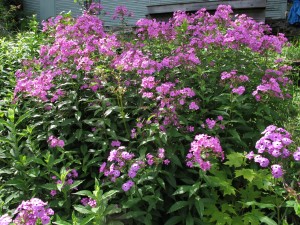Rainy Day Woes
It’s been rainy here in Cornish Flat. I can’t remember whether the recent bout of rain was 10 inches in 7 days or 7 inches in 10 days. But I do know that my old leather clogs appear to have grown a layer of mold that looked like the stuff that grows on phlox and lilacs, powdery mildew. Sigh. My tomatoes want some sunshine – and I do, too.
But all this rain is not all bad. Let me sing praises to the rain: First, we don’t have to water anything. Usually I have to water my vegetable transplants and seed beds. Not this year.
I like raised beds for everything but onions and celeriac (also called celery root, a wonderful substitute for celery in cooking). Those two plants need lots of water, so I usually do not plant them in raised beds because raised beds drain better and dry out quicker- which they don’t like. But when my stream overflowed, my onions suffered from the running water that ran through my garden while most other things were not affected. No matter, I just righted them and re-mulched around them.
Newly planted trees and shrubs are doing well with all this rain, too. They need an inch of water a week, and that has not been a problem this year. And I always have plants in pots waiting to go in the ground which normally have to be watered. I have a pink magnolia that I bought over a month ago that is still waiting to get planted – and I have only had to water it once.
That magnolia is a hybrid called ‘Jane’, one of eight varieties developed by the USDA in the 1950’s. I’m surprised it’s not more common in cold areas, as it is gorgeous, hardy to Zone 3 (minus 40) and has the added benefit of sporadic re-blooms in August. It is a small to medium sized tree. Others in the series include Betty, Judy and Ann and others often referred to as “the magnolia girls”. All bloom 2-4 weeks later than the early star magnolia, thus usually avoiding frost damage. I can’t wait!
On the other hand, all this rain has been heaven for slugs and snails. They like wet surfaces, and that’s about all we’ve had. What can we do about them? I always start by hand picking. My kale has suffered the most. Lower leaves have been very heavily grazed by small snails. I have gone around with a jar of soapy water, tapping the leaves to make the snails drop into the water. I also have pruned off some of the lower leaves – they were Swiss cheese-like and not contributing much to the plants.
Snails and slugs tend to avoid sharp surfaces, so sprinkling coarse sand on the soil surface should help discourage them, though it is hard to know the effect. I mean I can’t exactly interview them. (Mr. Slug, how do you feel about crawling over sand to get to the kale?”)
Slugs can be controlled with a product approved for organic gardeners. It’s called Sluggo and is iron phosphate (a naturally occurring mineral) covered with slug bait. I use it around the logs that I inoculated with spore plugs to produce Shitake mushrooms. I haven’t gotten any mushrooms yet this year – they bloom best in hot weather following a wet period. A small amount of Sluggo goes a long way and ends up being cheaper than the traditional method of putting out saucers of beer to attract and drown slugs. Which I find disgusting, anyway. I never have to deal with the slugs done in by Sluggo.
I haven’t yet done much mulching this year so there is lots of bare earth in my vegetable garden. Although that means that weeds get a “Get out of Jail Free” card, it also means that the soil dries out more quickly, which is a good thing. I use my CobraHead weeder to scratch the soil surface after rains to slice off any young weeds, but more importantly, to rough up the soil surface. A rough surface allows water to evaporate more quickly. And we need that.
The last good thing about all this rain is that big-rooted weeds pull more easily. The key is to pull them slooooowly. Gentle pressure. And if they don’t move, loosen the soil with a drain spade and try again.
So far this summer I haven’t gotten powdery mildew, that bothersome white fungus that so loves old fashioned phlox and lilacs. By August, I suppose it will be rampant. Hot wet weather makes plants more susceptible to it.
You can do something now, if you’ve had trouble with powdery mildew in past years: you can divide big clumps of phlox and other mold-prone plants. That way you will have better air circulation, allowing leaves to dry out before mold hyphae (rootlets) can penetrate the moist leaves. Even mildew-resistant cultivars will get moldy if the conditions are right.
So yes, I’m ready for sunny days. But rain does have plenty of good qualities. Let’s all try to appreciate it for the nectar it is for our plants.
Henry Homeyer can be reached at henry.homeyer@comcast.net. His Web site is www.Gardening-Guy.com.



